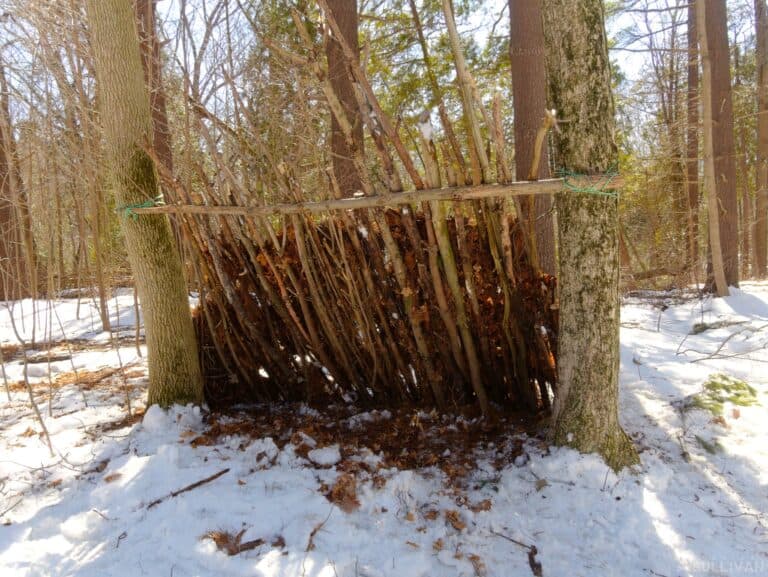Whether you’re getting ready to go camping or preparing for a potential survival situation out in the wilderness, there is no shortage of cutting-edge, high-tech shelter options today. From tents to bivvies, some of them offer truly miraculous protection from the elements!
But you won’t always have access to sleeping bags, tents, and tarps. Whether it is from loss, theft, damage, or just the simple fact that you couldn’t have anticipated the circumstances you find yourself in, you’ll have to make do with whatever shelter you can create or find…
Knowing how to craft or locate a primitive shelter can save your life when exposure is a real risk, and even if you know what you’re getting yourself into, a thorough working knowledge of various types of primitive shelters can allow you to do more with less gear.
Keep reading and I’ll tell you about a bunch of primitive shelters you need to know how to build…

front view of lean-to shelter in-between two trees
Lean-To
The classic lean-to is one of the oldest, most reliable, and certainly simplest primitive shelter designs known today.
With just a few scavenged materials it’s possible to whip one together in very little time. And you can put one together even quicker if you have a convenient tree or other object nearby to use as a base.
A lean-to is a one-sided shelter that gives you rudimentary protection from precipitation and wind- but only on the one side! It can help make the most of a fire, but it’s not a great choice if you’re dealing with seriously harsh conditions.
Nonetheless, most people start with a lean-to as their starting point and try to improve it or build a better one from there.
Wedge Hut
A wedge hut, or A-frame, is a little more than a double-sided lean-to, and is built the same way with interlocking branches on either side. A distinctive characteristic of the wedge hut is that it tapers down closer to the ground on the far end where your feet go.
It is compact, efficient, and relatively quick to build while offering much better protection, insulation, and all-around weather resistance compared to its simpler cousin design.
Thatched with leaves, soil, boughs, or other material it can do a good job of keeping rain and insects off of you.
However, one major shortcoming of this design is that you’ll only be warmed by a fire near the open end, and they aren’t wide enough as a rule for you to lie down sideways inside so you can warm your entire body at once.
Nonetheless, that is a small price to pay for greatly increased protection at a very modest increase in effort and materials.
Tipi
One of the most famous and iconic primitive shelters, and with good reason, a tipi is a large, comfortable, conical shelter that is built from long branches.
[TAG1]
They’re often vented at the top so that a small fire can be built inside for light, cooking, and heat without risking carbon monoxide buildup.
Traditionally, tipis were wrapped in buffalo hide or some other kind of leather, but they can be employed with various fabrics or scavenged materials.
Although they can be built in an open style, usually the outer covering is left long so that a flap can be closed as a door. Building a tipi is a fairly involved process but surprisingly simple with a little bit of practice and abundant material.
Wikiup
You might think of a wikiup as a cousin to the tipi, as it uses a similar conical shape and design that is capable of being opened or closed and vented at the top so that a small fire can be built inside.
The difference is that the walls of a wikiup are made entirely from branches or poles and then thatched with sod, leaf litter, or other material compared to a tanned hide or fabric as with a tipi.
Note that you’ll have to construct a panel or some other kind of door if you want to close it up completely, assuming you don’t have fabric or leather to work with.
Round Lodge
A round lodge can be thought of as a smaller halfway point between a tipi and a wikiup. It has the same conical structure of both, though a round lodge is typically much shorter.
[TAG2]
Round lodges also feature a fixed door frame and a solid door, though the door itself is often made out of a panel of branches lashed together.
If you don’t need or don’t have the time to build a wikiup or tipi, a round lodge is one of the best types of primitive shelters; they’ve been used with minor variations by cultures around the world and they are proven effective even in harsh weather when constructed properly.
If you might be in for a long stay they can be a highly efficient choice, especially in harsher climates.
Snow Cave
If you’re forced to survive in any area that has truly deep snowfall, a snow cave might be your best or only option.
A snow cave is an excavated shelter, relying on a little more than plenty of laborious digging and sometimes the shaping of snow into blocks or the packing of snow in order to form an entrance.
Basically, you dig straight into a drift of snow on a slope, creating a cave and a raised bench to sleep on along with a tiny hole in the ceiling for ventilation. They are still chilly, but significantly warmer inside than on the outside.
The obvious disadvantages of a snow cave include a high risk of collapse and potentially asphyxiation, especially if a candle or stove is used for supplementary heat.
Igloo
Igloos are famous semi-permanent survival shelters used in places where it is bitterly cold and there’s plenty of snow.
[TAG3]
Constructed partially out of shaped blocks of snow and packed, gathered snow, igloos are surprisingly durable and warm but challenging to construct. Tools are a must if you want to make good progress without freezing your hands.
Also, the quality of the snow itself is an important factor: What you really want is snow that is a suitable texture for making a perfect snowball. That way it can be fashioned into blocks and then packed. Loose powdery snow will fall apart and result in a collapse.
Quinzhee
Sometimes spelled “quintze,” think of this shelter as a kind of intermediate option between an igloo and a snow cave: it’s quicker and easier to build compared to an igloo, and nowhere near as dangerous or failure-prone as a snow cave.
To make a quinzhee, all you need to do is mound up a thin layer of debris or material (leaves, boughs, tarp, etc.) over any roughly dome-shaped pile there’s about big enough for you to take shelter under.
The pile in the middle could be anything, from rocks and branches to your own gear if you have enough. Then you pack snow over the debris layer and let it set.
After that, you carefully excavate whatever you used to make the dome and the intermediate layer. Presto! A simple, dome-shaped shelter made of snow.
Tree Pit
A tree pit is a unique shelter specially adapted to cold weather survival, specifically in areas that have deep snowfall.
By finding a mature, healthy tree that has branches close to the surface snowline, you can dig a pit down to the ground around the trunk to take shelter in, lining the ground with grass, branches, pine needles in the like.
The branches that are close to the snow line on the surface will act like a roof that will help trap heat inside, and these can be supplemented with other gathered branches to make a surprisingly insulated shelter.
Debris Hut
A debris hut is among the simplest of primitive survival shelters, and one of the quickest to create in a hurry. It’s nothing more than a giant mound of natural debris, hopefully, things that can keep you warm like leaves, moss, branches, sod, and the like. Then all you do is dig out a pocket, or cubbyhole, that is just big enough for you to wriggle inside.
The larger the mound the more insulation and the better warmth it will provide, especially if you have good clothing on or other survival gear. Although it can hardly be called a structure, it can definitely save your life when time is at a premium and temperatures are falling.
Salish
A salish is a type of partially subterranean shelter used by indigenous American peoples all along the West Coast of the continent, all the way up into Alaska.
It’s basically a dugout and smoothed pit with a central pole that helps to prop up a short wikiup-type conical structure that is thatched with earth and grass.
The digging of the central pit is highly laborious, of course, but this offsets the overall height of the structure and means you can enjoy more room while using less material when building the walls and roof.
Salish shelters are strong, and a great choice for dealing with higher winds and chilly temperatures. They’re easy to keep warm and very roomy.
The obvious downside is that if you don’t have anything to dig with or if the ground is very tough to dig, it’s probably not worth it.
Tree Root Shelter
If you’re able to find a large, mature tree that has some of the soil eroded out from beneath its roots, it will form a hollow that, with a little extra excavation and insulation, is perfect as a ready-made shelter.
The great things about a tree root shelter are that it is very strong, requires little relative effort to make, and can give you excellent protection from wind and rain alike with a few simple modifications.
Cave
Don’t underestimate the value of a simple cave when it comes to shelter! A proper cave or even a suitably large depression in a rock face can make a wonderful enclosure against wind, rain, heat, or cold. A fire can be built nearby, or you might even be able to build it safely inside if the smoke will drift back out.
[TAG4]
Obviously, making use of a cave as a shelter is completely terrain dependent, and you’ve got to be cautious that there isn’t some large and dangerous animal sheltering further inside! Generally, though, if you can make use of a cave for shelter you are well advised to.
Swamp Bed
If you’re in a marsh, bog, or a proper swamp then a swamp bed is what you need to get up out of the muck and mire.
Using a convenient fallen tree or a sturdy, larger branch, you can make a simple frame that can then be lined with multiple smaller branches and sticks to form an all-natural cot of sorts.
This can then be insulated with any gathered, dry material that you can find or other supplies you happen to have on hand. Staying off of that wet ground alone will go very far toward keeping you warm in such damp conditions!

The post 14 Primitive Shelters You Can Make in the Wild appeared first on Survival Sullivan.
By: Tom Marlowe
Title: 14 Primitive Shelters You Can Make in the Wild
Sourced From: www.survivalsullivan.com/primitive-shelters/
Published Date: Tue, 30 Jan 2024 09:54:51 +0000
------------------------
Did you miss our previous article...
https://bushcrafttips.com/bushcraft-news/are-tasers-legal-in-mississippi-what-you-should-know
 What is BushcraftSurvival SkillsToolsVideosBushcraft CampsBushcraft KitsBushcraft ProjectsPrivacy PolicyTerms And Conditions
What is BushcraftSurvival SkillsToolsVideosBushcraft CampsBushcraft KitsBushcraft ProjectsPrivacy PolicyTerms And Conditions
